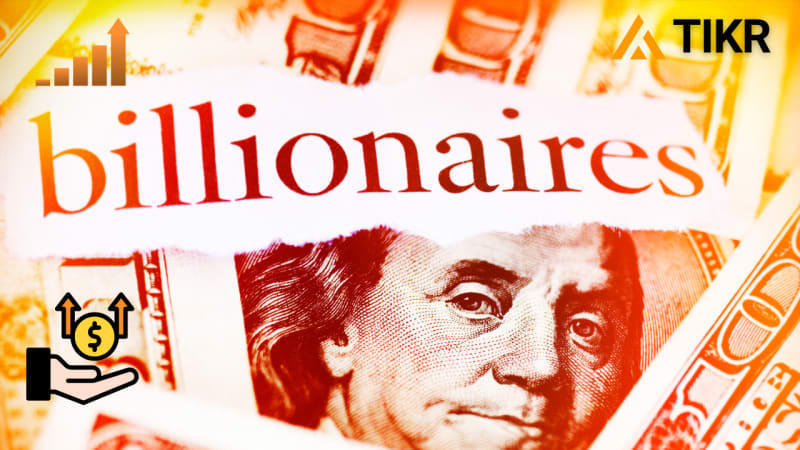When most investors think of billionaires who move markets, names like Warren Buffett, Ray Dalio, and Carl Icahn come to mind. But beyond those headlines are a handful of ultra-successful investors quietly compounding wealth with discipline and precision, the kind of long-term track records that command respect among professionals. These lesser-known billionaires operate at the intersection of conviction and data, deploying billions across global markets while staying out of the spotlight.
For retail investors, watching what these managers are buying and understanding why they do so can be invaluable. It’s not about copying their trades; it’s about decoding their logic. Each position reflects months of research, macro perspective, and risk calibration. And thanks to tools like TIKR, investors can now track their 13F filings, holdings, and performance shifts in real time, giving ordinary investors access to institutional-level insights once reserved for hedge-fund insiders.
| Investor | Fund / Family Office | Recent Buys (2025) | Core Theme |
|---|---|---|---|
| Stanley Druckenmiller | Duquesne Family Office | Added Nvidia, new stakes in Palo Alto Networks, Meta | AI infrastructure & digital resilience |
| Philippe Laffont | Coatue Management | Expanded Arm Holdings, Snowflake, ServiceNow | Enterprise AI and software scalability |
| David Tepper | Appaloosa Management | Increased Amazon, Meta, Nvidia | Growth reacceleration & liquidity rotation |
| Stephen Mandel | Lone Pine Capital | Added Adobe, Microsoft, Amazon | Cloud efficiency & global consumer rebound |
| Daniel Sundheim | D1 Capital Partners | Built stakes in Rolls-Royce, Siemens Energy, UniCredit | European industrial and financial recovery |
Below are five billionaires who don’t always make headlines but consistently make the right calls, along with their latest positions, revealing where they see opportunity heading into 2025.
1. Stanley Druckenmiller
Stanley Druckenmiller’s name rarely trends on social media, but among professionals, he’s a legend. As George Soros’s former chief strategist at the Quantum Fund, Druckenmiller helped engineer one of the greatest trades in history, shorting the British pound in 1992. Since founding Duquesne Family Office, he’s delivered decades of double-digit returns without a single down year before closing his fund to outside investors. What sets him apart isn’t luck or leverage, it’s discipline. Druckenmiller blends top-down macro awareness with bottom-up conviction, and he’s never afraid to pivot when conditions change.
His recent 13F filings show that he’s leaning into the AI infrastructure trade, not just the headline names. Duquesne Family Office added to Microsoft and initiated new positions in Caesars, DocuSign, and Roku, while trimming exposure to consumer discretionary and rate-sensitive sectors.
That combination suggests he sees real value not in speculative “AI startups,” but in established ecosystems that build and secure the hardware backbone of the digital economy. His $2.4 billion U.S. portfolio is now concentrated around semiconductors, cloud infrastructure, airlines, and cybersecurity, themes he believes will anchor the next cycle of productivity.
What retail investors can take from Druckenmiller is his precision. He doesn’t chase narratives, he identifies durable drivers and lets time compound the thesis. In 2025, that means staying focused on businesses powering the “digital supply chain,” from data centers to chips to security. As always, when Druckenmiller moves, he’s usually early and usually right.
2. Philippe Laffont

Track the world’s best investors and hedge fund portfolios with TIKR (It’s free) >>>
Philippe Laffont may not have the cult following of Cathie Wood or Bill Ackman, but in Silicon Valley and New York, he’s known as one of the sharpest minds in tech investing. A former Tiger Management analyst, Laffont founded Coatue Management in 1999 and turned it into a $50 billion powerhouse with a laser-focused mission: find technology platforms with defensible moats, durable margins, and exponential optionality. He’s known for using proprietary data models that track everything from app downloads to cloud utilization rates, all in the service of finding scalable growth before it hits consensus.
Coatue’s latest filings show a renewed appetite for AI-linked semiconductors, software infrastructure, and cloud enablers. The firm added to Arm Holdings, NVIDIA, and Hut 8, while trimming some overextended consumer-internet names.
This suggests Laffont is positioning for a second wave of AI adoption, less about hype, more about enterprise integration. Coatue also expanded positions in digital payments and cybersecurity firms that benefit from AI-driven automation, a move echoing his 2020 playbook during the SaaS expansion boom.
What separates Laffont from most growth investors is his patience with transformation curves. He’s willing to endure short-term volatility for long-term dominance, but only if the data supports it. Retail investors tracking Coatue on TIKR can see his conviction patterns clearly: scaling in after drawdowns, trimming after parabolic runs, and staying anchored to usage metrics rather than headlines. If you want to understand how institutional investors turn data into alpha, Coatue’s portfolio is a masterclass.
3) David Tepper: The Contrarian Capital Allocator
David Tepper built his fortune by doing what few dare: buying when everyone else is panicking. Through Appaloosa Management, he turned distressed debt trades into billions, earning a reputation as one of Wall Street’s boldest contrarians. But beneath that swagger lies analytical rigor, a man who reads balance sheets like road maps and times cycles with uncanny precision. His record speaks for itself: consistent outperformance across equities, credit, and macro environments.
The most recent 13F shows Appaloosa’s new positions in Intel, RTX, and IQVIA, while modestly trimming Apple and casino holdings. On the surface, it looks like “more tech,” but context matters. Tepper tends to ramp exposure when liquidity is improving and forward earnings revisions turn positive. His portfolio positioning aligns neatly with a “soft-landing” thesis: the idea that economic growth and lower inflation can coexist, favoring growth sectors once more. It’s no accident his AI and cloud bets coincide with the Fed’s easing signals.
For investors, Tepper’s moves underline one simple truth: the best contrarians aren’t reckless, they’re calculated. When quality companies sell off on macro fear, he steps in. That philosophy doesn’t require billions; it just requires nerve and preparation. Tracking Tepper’s 13F on TIKR can reveal when his conviction shifts, and those inflection points often foreshadow broader sentiment changes across the market.
4. Stephen Mandel

Quickly find new billionaire stock buys with TIKR (It’s free) >>>
Stephen Mandel is a quiet powerhouse. As the founder of Lone Pine Capital, he has spent decades refining a model of “growth at a reasonable price,” a strategy that combines deep fundamental research with a trader’s agility. His analysts are famous for building intricate unit-economics models, dissecting customer cohorts, and stress-testing long-term assumptions. The result: one of the most admired track records in hedge-fund history.
Lone Pine’s latest filings show increased exposure to cloud infrastructure and high-quality consumer platforms, particularly in companies such as UnitedHealth, Brookfield Corp, and Booking Holdings.
Mandel’s lesson for retail investors is timeless: real growth compounds quietly. He avoids fads, favors operating leverage over headline momentum, and only invests where margins expand with scale. Using TIKR’s holdings tracker, you can map Mandel’s quarterly adjustments against valuation trends, a great way to understand how institutional investors navigate volatility while staying true to intrinsic value.
5. Daniel Sundheim
Daniel Sundheim doesn’t seek attention, he seeks alpha. After serving as CIO at Viking Global, he launched D1 Capital Partners in 2018, blending the best of both worlds: private-market insight and public-market agility. His portfolio spans tech, industrials, and financials, but his secret weapon is flexibility, he can shift regions, sectors, or strategies faster than most large funds.
He maintains core positions in the U.S. and around the world, keeping exposure to tech names like AppLovin Corp. and Amazon while adding to niche infrastructure names. The result: a globally diversified book that still reflects clear thematic conviction.
For investors, Sundheim’s approach shows the advantage of a broad vision. He’s not chasing trends, he’s rebalancing across time zones and cycles. If you’re tracking D1’s holdings on TIKR, you’ll see a pattern: concentration in quality, rotation into value, and constant alignment with multi-year capital flows. His message is simple: look where the next growth wave is forming, not just where it’s already breaking.
Why This Matters (and How to Track It Yourself)
The beauty of today’s markets is that anyone can access this level of insight. With TIKR, you can instantly pull up each of these managers’ holdings, see new buys, compare sector weightings, and even track valuation metrics alongside ownership trends. What used to require a Bloomberg Terminal and an analyst team now takes less than five minutes.
To follow these billionaires effectively:
- Go to TIKR → “Track Investing Gurus”
- Type the billionaire’s fund name (e.g., “Duquesne Family Office”).
- Sort by “Change in # of Shares Held” to see conviction levels.
- Open the stock page to cross-reference valuation and fundamentals.
In seconds, you’ll see the story behind their conviction, not just the tickers, but the rationale.
See what the world’s best investors are buying today with TIKR (It’s free) >>>
TIKR Takeaway
Tracking billionaire investors isn’t about imitation; it’s about education. Every move reflects a process, one grounded in data, discipline, and conviction. TIKR makes that process visible. You can watch trends unfold across funds, identify consensus trades, and spot emerging divergence before the crowd reacts.
Whether you’re looking for confirmation on your own thesis or building a new watchlist, it’s the fastest way to think like a professional investor without needing institutional access.
These five billionaires may not dominate headlines, but they dominate performance. And thanks to modern tools, their playbooks are now open to anyone who knows where to look.
Value Any Stock in Under 60 Seconds (It’s Free)
With TIKR’s new Valuation Model tool, you can estimate a stock’s potential share price in under a minute.
All it takes is three simple inputs:
- Revenue Growth
- Operating Margins
- Exit P/E Multiple
If you’re not sure what to enter, TIKR automatically fills in each input using analysts’ consensus estimates, giving you a quick, reliable starting point.
From there, TIKR calculates the potential share price and total returns under Bull, Base, and Bear scenarios so you can quickly see whether a stock looks undervalued or overvalued.
Estimate a company’s fair value instantly (Free with TIKR) >>>
Looking for New Opportunities?
- Discover which stocks billionaire investors are purchasing, so you can follow the smart money.
- Analyze stocks in as little as 5 minutes with TIKR’s all-in-one, easy-to-use platform.
- The more rocks you overturn… the more opportunities you’ll uncover. Search 100K+ global stocks, global top investor holdings, and more with TIKR.
Disclaimer:
Please note that the articles on TIKR are not intended to serve as investment or financial advice from TIKR or our content team, nor are they recommendations to buy or sell any stocks. We create our content based on TIKR Terminal’s investment data and analysts’ estimates. Our analysis might not include recent company news or important updates. TIKR has no position in any stocks mentioned. Thank you for reading, and happy investing!








